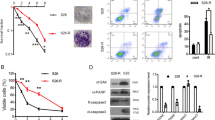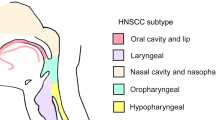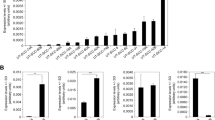Abstract
Retinoids can regulate the proliferation and differentiation of various tumor cells. It is thought that nuclear retinoid receptors mediate these effects by regulating gene transcription. The identity of specific retinoid target genes is only beginning to be unraveled. One candidate for mediating retinoid-induced growth suppression is the novel class II tumor suppressor gene tazarotene-induced gene 3 (TIG3). We examined the constitutive and all-trans retinoic acid (ATRA)-inducible expression of TIG3 mRNA in five head and neck squamous cell carcinoma (HNSCC) and five nonsmall cell lung carcinoma (NSCLC) cell lines to determine whether it is associated with their responsiveness to ATRA. The expression patterns of retinoic acid receptor β (RARβ), another putative retinoid-inducible tumor suppressor gene, were also examined. The constitutive TIG3 expression was high in one HNSCC cell line and two NSCLC cell lines, and moderate to very low in the other cells. Some RARβ-expressing cells had either low or undetectable TIG3 levels and vice versa. ATRA (1 μ M; 48 h) increased TIG3 mRNA in 4/5 HNSCCs and 3/5 NSCLCs and RARβ mRNA in some of the same cell lines, but also in cells that did not show TIG3 induction. TIG3 mRNA was induced by ATRA between 6 and 12 h in most of the responsive cells. ATRA concentrations required for TIG3 induction ranged from 1 to 500 nM depending on the cell line. The pan-RAR antagonists AGN193109 and the RARα antagonist Ro 41-5253 blocked TIG3 induction by ATRA. ATRA suppressed anchorage-independent colony formation in most cells that had a high or moderate constitutive or induced TIG3 expression level. In contrast, RARβ mRNA expression pattern was not correlated with sensitivity to ATRA. These results suggest that TIG3 is regulated by ATRA via retinoid receptors in certain aerodigestive tract cancer cells, and its induction by ATRA is associated with the suppression of anchorage-independent growth.
This is a preview of subscription content, access via your institution
Access options
Subscribe to this journal
Receive 50 print issues and online access
$259.00 per year
only $5.18 per issue
Buy this article
- Purchase on Springer Link
- Instant access to full article PDF
Prices may be subject to local taxes which are calculated during checkout





Similar content being viewed by others
References
Altucci L and Gronemeyer H . (2001) Nat. Rev. Cancer, 1, 181–193.
Aoudjit F, Brochu N, Morin N, Poulin G, Stratowa C and Audette M . (1995). Cell Growth Differ., 6, 515–521.
Apfel C, Bauer F, Crettaz M, Forni L, Kamber M, Kaufmann F, LeMotte P, Pirson W and Klaus M . (1992). Proc. Natl. Acad. Sci. USA, 89, 7129–7133.
Berard J, Laboune F, Mukuna M, Masse S, Kothary R and Bradley WE . (1996). FASEB J., 10, 1091–1097.
Casanova B, de la Fuente MT, Garcia-Gila M, Sanz L, Silva A, Garcia-Marco JA and Garcia-Pardo A . (2001) Leukemia, 15, 1521–1526.
Chambon P . (1996). FASEB J., 10, 940–954.
Cheng Y, and Lotan R . (1998). J. Biol. Chem., 273, 35008–35015.
de The H, Vivanco-Ruiz MM, Tiollais P, Stunnenberg H and Dejean A . (1990). Nature, 343, 177–180.
Deucher A, Nagpal S, Chandraratna RA, Di Sepio D, Robinson NA, Dashti SR and Eckert RL . (2000). Int. J. Oncol., 17, 1195–1203.
Di Sepio D, Ghosn C, Eckert RL, Deucher A, Robinson N, Duvic M, Chandraratna RAS and Nagpal S . (1998). Proc. Natl. Acad. Sci. USA, 95, 14811–14815.
Dressler D, Sarang Z, Szondy Z, Engelhart K and Grafstrom RC . (2002). Int. J. Oncol., 20, 897–903.
Duvic M, Helekar B, Schulz C, Cho M, DiSepio D, Hager C, DiMao D, Hazarika P, Jackson B, Breuer-McHam J, Young J, Clayman G, Lippman SM, Chandraratna RAS, Robinson NA, Deucher A, Eckert RL and Nagpal S . (2000). Clin. Cancer Res., 6, 3249–3259.
Gudas LJ, Sporn MB and Roberts AB . (1994). The Retinoids. Sporn MB, Roberts AB and Goodman DS (eds). Raven Press: New York, pp. 443–520.
Hajnal A, Klemenz R and Schafer R . (1994). Oncogene, 9, 479–490.
Hong WK and Itri LM . (1994). The Retinoids. Sporn MB, Roberts AB and Goodman DS (eds). Raven Press: New York, pp. 597–630.
Houle B, Rochette-Egly C and Bradley WE . (1993). Proc. Natl. Acad. Sci. USA, 90, 985–989.
Huang SL, Shyu RY, Yeh MY and Jiang SY . (2000). Mol. Cell. Endocrinol., 159, 15–24.
Huang SL, Shyu RY, Yeh MY and Jiang SY . (2002). Anticancer Res., 22, 799–804.
Husmann K, Sers C, Fietze E, Mincheva A, Lichter P and Schafer R . (1998) Oncogene, 17, 1305–1312.
Johnson AT, Klein ES, Gillett SJ, Wang L, Song TK, Pino ME and Chandraratna RAS . (1996). J. Med. Chem., 38, 4764–4767.
La Vista-Picard N, Hobbs PD, Pfahl M, Dawson MI and Pfahl M . (1996). Mol. Cell. Biol., 16, 4137–4146.
Lee SW, Tomasetto C and Sager R . (1991). Proc. Natl. Acad. Sci. USA, 88, 2825–2829.
Lehman TA, Bennett WP, Metcalf RA, Welsh JA, Ecker J, Modali RV, Ullrich S, Romano JW, Appella E, Testa JR, Gerwin BI and Harris CC . (1991). Cancer Res., 51, 4090–4096.
Liu TX, Zhang JW, Tao J, Zhang RB, Zhang QH, Zhao CJ, Tong JH, Lanotte M, Waxman S, Chen SJ, Mao M, Hu GX, Zhu L and Chen Z . (2000). Blood, 96, 1496–1504.
Lotan, R . (1996). FASEB J., 10, 1031–1039.
Mangelsdorf DJ, Umesono K and Evans RM . (1994). The Retinoids. Sporn MB, Roberts AB and Goodman DS (eds). Raven Press: New York, pp. 319–349.
Mao M, Yu M, Tong JH, Ye J, Zhu J, Huang QH, Fu G, Yu L, Zhao SY, Waxman S, Lanotte M, Wang ZY, Tan JZ, Chan SJ and Chen Z . (1996). Proc. Natl. Acad. Sci. USA., 93, 5910–5914.
Mitsudomi T, Steinberg SM, Nau MM, Carbone D, D'Amico D, Bodner S, Oie HK, Linnoila I, Mulshine JL, Minna JD and Gazdar AF . (1992). Oncogene, 7, 171–180.
Moon RC, Mehta RG, and Rao KJVN . (1994). The Retinoids. Sporn MB, Roberts AB and Goodman DS (eds), Raven Press: New York, pp. 573–595.
Moroni MC, Vigano MA and Mavilio F . (1993). Mech. Dev., 44, 139–154.
Nagpal S, Athanikar J and Chandraratna RAS . (1995). J. Biol. Chem., 270, 923–927.
Oridate N, Lotan D and Lotan R . (1996a). In Vitro Cell Dev. Biol., 32, 192–193.
Oridate N, Esumi N, Lotan D, Hong WK, Rochette-Egly C, Chambon P . (1996b). Oncogene, 12, 2019–2098.
Reiss M, Brash DE, Munoz-Antonia T, Simon JA, Ziegler A, Vellucci VF and Zhou ZL . (1992). Oncol. Res., 4, 349–357.
Sun S-Y, Yue P, Dawson MI, Shroot B, Michel S, Lamph WW, Heyman RA, Teng M, Chandraratna RAS, Shudo K, Hong WK and Lotan R . (1997), Cancer Res., 57, 4931–4939.
Sun S-Y, Yue P, Mao L, Dawson MI, Shroot B, Lamph WW, Heyman RA, Chandraratna RAS, Shudo K, Hong WK and Lotan R . (2000). Clin. Cancer Res., 6, 1563–1573.
Wan H, Hong WK and Lotan R . (2001) Cancer Res., 61, 556–564.
Wakeman JA, Walsh J and Andrews PW . (1998). Oncogene, 17, 179–186.
White JA, Beckett-Jones B, Guo YD, Dilworth FJ, Bonasoro J, Jones G and Petkovich M . (1997). J. Biol. Chem., 272, 18538–18541.
Xu L, Glass CK and Rosenfeld MG 1999). Curr. Opin. Genet. Develop., 9, 140–147.
Acknowledgements
We thank Dafna Lotan for her excellent technical assistance. We also thank Dr Sarah Wardlaw for critically reading this manuscript. This study was supported in part by P50 DE11906 grant from the National Institute of Dental and Craniofacial Research and by PO1 CA52051, U19 CA68437, and CCSG CA16672 (DNA Sequencing Core) grants from the National Cancer Institute.
Author information
Authors and Affiliations
Corresponding author
Rights and permissions
About this article
Cite this article
Higuchi, E., Chandraratna, R., Hong, W. et al. Induction of TIG3, a putative class II tumor suppressor gene, by retinoic acid in head and neck and lung carcinoma cells and its association with suppression of the transformed phenotype. Oncogene 22, 4627–4635 (2003). https://doi.org/10.1038/sj.onc.1206235
Received:
Revised:
Accepted:
Published:
Issue Date:
DOI: https://doi.org/10.1038/sj.onc.1206235
Keywords
This article is cited by
-
The rise and fall of anandamide: processes that control synthesis, degradation, and storage
Molecular and Cellular Biochemistry (2021)
-
Ameliorating effect of lipo-ATRA treatment on the expression of TIG3 and its suppressing effect on PPARγ gene expression in lung cancer animal model
Molecular and Cellular Biochemistry (2019)
-
The Ribosomal Protein RPLP0 Mediates PLAAT4-induced Cell Cycle Arrest and Cell Apoptosis
Cell Biochemistry and Biophysics (2019)
-
Genome-wide identification of target genes for miR-204 and miR-211 identifies their proliferation stimulatory role in breast cancer cells
Scientific Reports (2016)
-
The antitumor effect of TIG3 in liver cancer cells is involved in ERK1/2 inhibition
Tumor Biology (2016)



